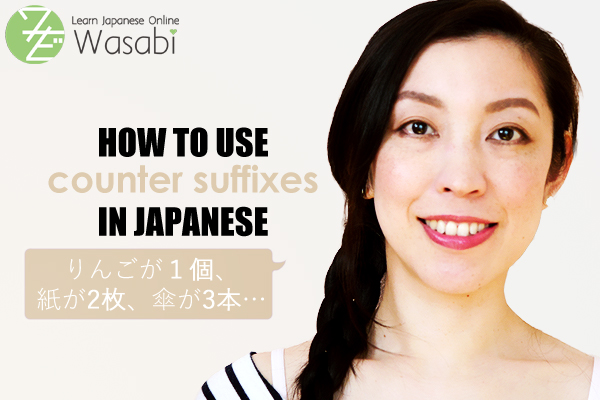How to use counter suffixes in Japanese
Welcome back to another “Video & Article” series with tutor Wakako. In this article and video we will take a look at counter suffixes in Japanese. There are many counter suffixes in Japanese, and each is used to count a different type of object, and some are for specific types of animals. Learnt he most common counter suffixes and which objects/animals to count with them in this lesson!
[Introduction]
When counting in Japanese, you will need to put certain counter words after the number, like “1個”, “1本”, “1枚” or “1人”. Depending on what you count, this counter word changes. Additionally, there are many irregular readings for specific number and counter words combinations. In today’s lesson, we will introduce some of the most common counter words and how to read them!
[adsense]
[Counting small, round things: 個]
When you count small, round objects such as balls, eggs, or apples, you use the counter suffix “個”: 1個, 2個, 3個, etc.
Example:
りんごを1個ください!
One apple please!
[Counting thin/flat things: 枚]
When you count thin or flat objects like sheets of paper, plates, or CDs you use “枚”: 1枚, 2枚, 3枚, etc.
Example:
紙を3枚印刷しました。
I printed three sheets of paper.
[Counting long & narrow things: 本]
If you count long (but narrow) things like bananas, umbrellas or pens, you use “本”: 1本, 2本, 3本, etc.
With “本” (ほん) the reading changes depending on the number it is combined with. When you count 1, 6, 8, and 10, it is read “ぽん” with a small “っ” in between, as in: いっぽん, ろっぽん, はっぽん, じゅっぽん.
When combined with the number three, “本” reads as “ぼん”. With all other numbers it is read as “ほん”. Even if you go higher than ten, depending on the number right before the counter suffix, the reading is again adjusted by the rules above. E.g: 11本 is read as “じゅういっぽん”.
1本 = いっぽん
2本 = にほん
3本 = さんぼん
4本 = よんほん
5本 = ごほん
6本 = ろっぽん
7本 = ななほん
8本 = はっぽん
9本 = きゅうほん
10本 = じゅっぽん
11本 = じゅういっぽん
12本 = じゅうにほん
13本 = じゅうさんぼん
14本 = じゅうよんほん
15本 = じゅうごほん
16本 = じゅうろっぽん
17本 = じゅうななほん
18本 = じゅうはちほん
19本 = じゅうきゅうほん
20本 = にじゅっぽん
[Counting people: 人]
People are count with the word “人” (read “にん” in this case). However, when combined with the numbers one or two, this is read as “1人” = “ひとり”, and “2人” = “ふたり”. If the number is three or higher, “人” is read as “にん”, e.g. “3人” = “さんにん”, and “4人” = “よにん”.
Example:
1人ですか?
Are you alone?
いいえ、3人です。
No, we are three people.
[Counting animals: 匹 & 羽]
When counting animals, you use “匹”. However, a different counter suffix is used for birds. Birds are counted with “羽”.
When reading “匹”, the same rules apply as for “ほん”: When combined with 1, 6, 8, and 10, “匹” is read as “ぴき” with a small “っ” in front. When combined with 3, it is read as “びき”. With all other numbers, it is read as “ひき”. いっぴき、にひき、さんびき、よんひき… etc.
Funnily enough, rabbits, albeit not being birds, are counted using “羽”. One assumed reason for this dates back to the Edo period. During the Edo period, the Buddhist religion started to spread widely, and Buddhist doctrine forbids the consumption of meat from animals with four legs. However, people eager to eat meat tried to bypass this by pretending rabbits were birds, and not “animals with four legs”. Thus, people started to count rabbits with the counter suffix “羽”.
[Counting books: 冊]
Books, magazines, notebooks, and textbooks are all counted with the counter word “冊”.
Example:
日本語の教科書6冊も持って帰ろうとしていたけど、重すぎてできなかった!
I tried to carry home six Japanese textbooks, but they were so heavy I couldn’t do it!
[Counting electronic devices: 台]
Electronic machinery like TVs, refrigerators, or computers are counted using the counter suffix “台”.
Example:
彼はパソコンを4台も持っているらしいですよ!
Apparently he owns 4 computers!
[Counting pairs of objects: 膳, 箸 & 本]
Things that come in pairs also have different counter suffixes depending on the type of object that you want to count. A pair of socks or shoes is counted using “膳”, a pair of chopsticks is counted with “膳”, and a pair of trousers or pants is counted with “本”, just like bananas, umbrellas, and pens.
Example:
今日は靴下を2膳、おはし1膳とズボンを2本買った!
Today I bought two pairs of socks, one pair of chopsticks, and two trousers!
That is all for today’s lesson. If you have any questions you can always clear them up by booking a lesson with one of our native Japanese tutors. See you next time!
| 数える | To count |
| 数字 | Number |
| 個 | Counter suffix for small, round things (apples, eggs, balls, etc.) |
| 枚 | Counter suffix for flat, thin things (sheets of paper, plates, pizza, etc.) |
| 本 | Counter suffix for long, thin objects (umbrellas, pens, bananas, etc.) Counter suffix for trousers |
| 人 | Counter suffix for people |
| 匹 | Counter suffix for small animals (like cats, dogs, etc.) |
| 羽 | Counter suffix for birds and rabbits |
| 冊 | Counter suffix for books, magazines etc. |
| 台 | Counter suffix for electronic devices (TVs, refrigerators, computers, etc.) |
| 膳 | Counter suffix for pairs of socks, shoes |
| 膳 | Counter suffix for pairs of chopsticks |





